How to Build A Campfire: Building a campfire can be difficult without the proper materials. Here We learn how to build the best campfire to stay warm.
Building a fire may be convenient and enjoyable as long as it’s done safely. Camp Fire safety is a severe thing and if not done properly can lead to major and dangerous outcomes. With the help of a campfire, whether it be in the winter or the summer, you can brighten the night, keep warm, and prepare delectable dishes and desserts when camping.
In this article, we’ll take you through the step-by-step process of how to build a campfire that is safe, efficient, and enjoyable and how to maintain a fire from beginning to end.
How to Build A Campfire
Choose the Right Location
Before starting your campfire, selecting the perfect location is crucial to minimize the risk of accidents. Here are some essential tips:
- Look for a flat and level surface away from flammable objects like tents, branches, and dry leaves.
- Check local regulations or restrictions regarding campfires in the area you plan to camp.
- Avoid building a fire near water sources to prevent damage to the ecosystem.
Find or Make a Fire Pit
Most camping sites you may go to already have built-in fire pits which work great. Some of these could also have a grate built in which allows you to cook over the fire. When it comes to deciding which type of fire pit to use, these are great, viable, and simple options.
If the fire pit is full of old coals and ash we recommend getting a stick and trying to spread it out evenly across the fire pit so there is no pile-up of holes.
You will need to build your fire pit if there isn’t one already. To do this gather medium to large size rocks which are stackable. Once you have collected your rocks, find the spot where you want to build the fire and dig a hole shallow but wide enough to fit your fire.
Finally, until your pit is complete, you will need to pile your rocks in a circle around your hole about two or three feet in height.
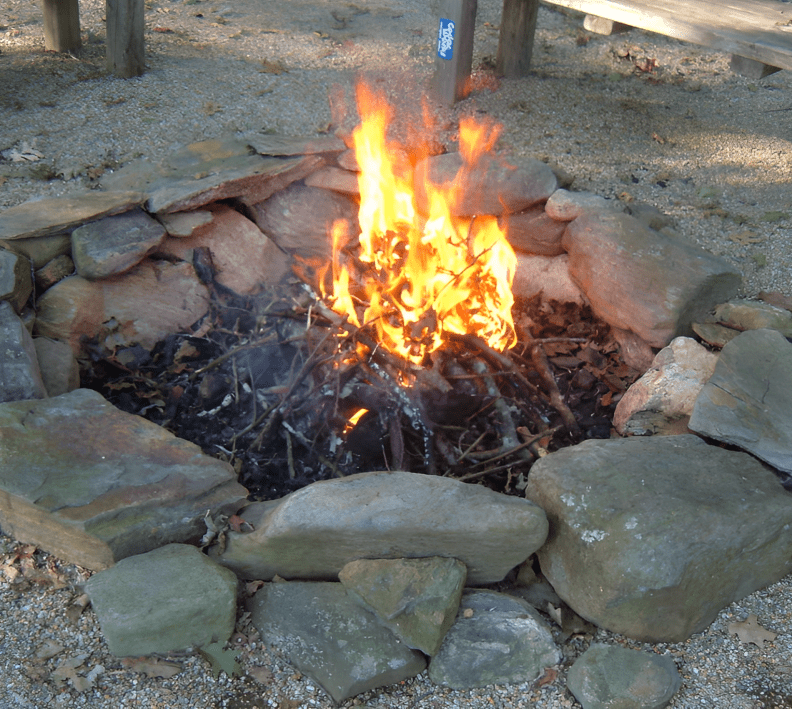
Build up your fire
It is preferable if you bring your firewood as it is less harmful to the environment and will reduce your impact on your campsite. Sometimes it is not possible to bring your own so will have to gather it yourself.
- READ ALSO : Camping Hygiene: How to Stay Clean When Camping
You should only gather dead and fallen wood when gathering wood. You’ll need three distinct kinds of wood: firewood, kindling, and tinder. Each of these are different sizes and types as seen in the picture above.
Now that you have wood, it is time to build the beginnings of your fire. There are many different ways to do this but we will show you a few of the best and easiest ways.
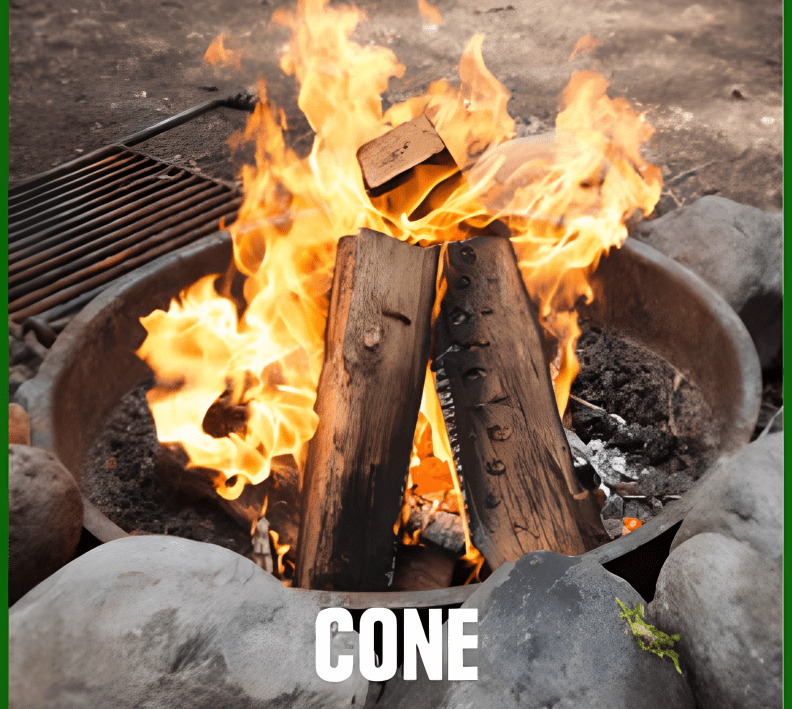
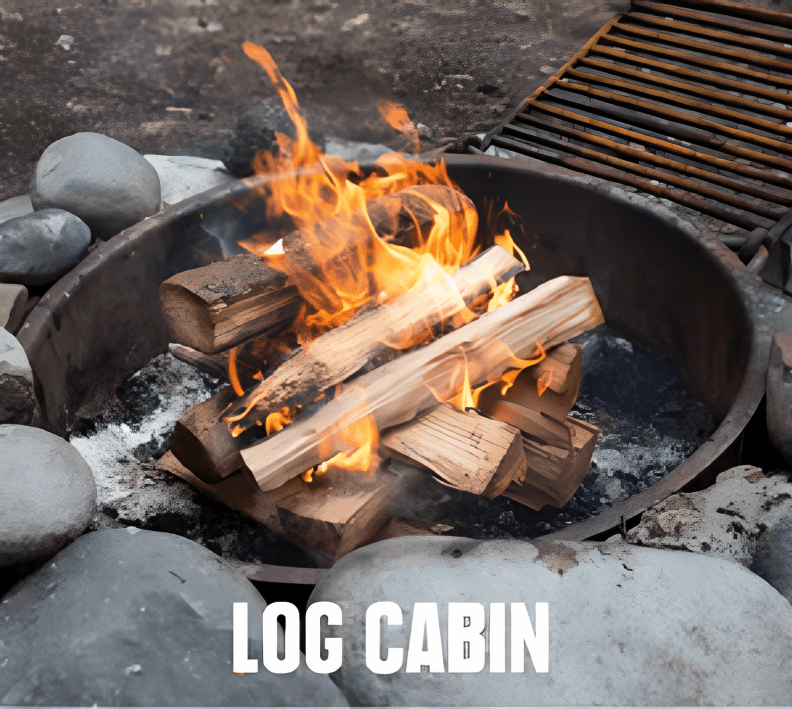

Lighting Your Fire
It’s time to light your wood after you’ve built it up. Light the tinder and let the flames grow from there in all of the different builds. A long neck lighter is recommended since it is the simplest and safest way to reach the tinder pile.
You can still use a little lighter or match to ignite it. Start igniting the tinder until you see flames, regardless of lighter or build. If the kindling does not catch fire easily, you can gently blow toward it to supply additional oxygen to the fire, which will help it grow.
Once the kindling and firewood begin to burn gradually add more wood until the desired size is reached. Make sure to stay safe and make sure your fire does not exceed the fire pit. As the fire continues to burn safely push the hot coals toward the center which will help ignite new logs put on.
Extinguishing the Campfire
Once you think you may want to put out the fire soon stop adding new wood to help you put it out when you are done with it. The easiest way to extinguish your campfire requires the fire to run down until it is only coals with no flames.
When you reach this point, you should pour a large amount of water on the hot embers. Distribute the water and coals evenly around the fire pit. Repeat the watering and spreading process until the coals are cool to the touch (be careful not to grab hot coals).
Check to ensure that the fire is completely out and that there are no hot embers or coals anywhere near or in your pit. This will assure fire safety by ensuring that nothing goes wrong after you leave your fire.
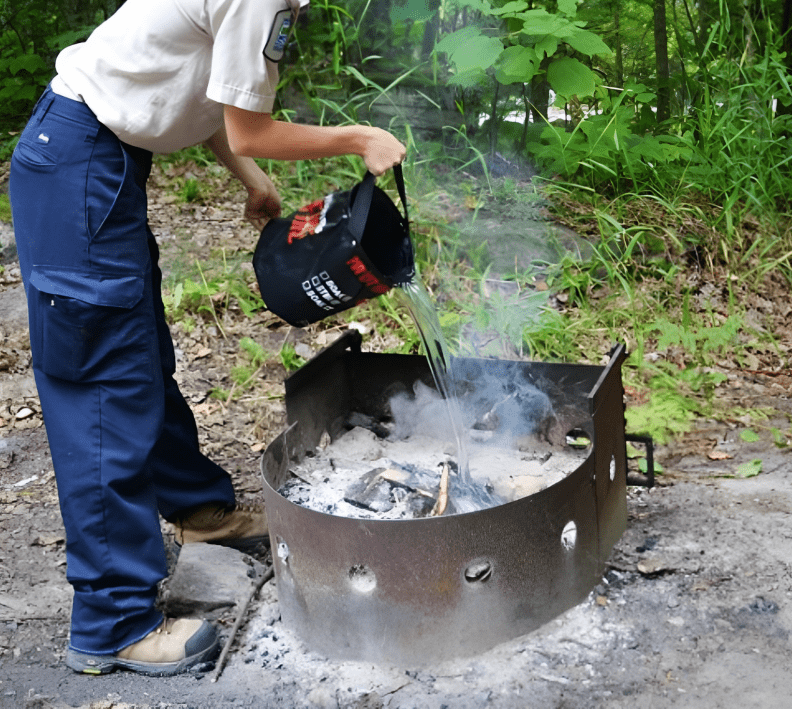
Campfire Safety
- Before planning your camping adventure, check local fire restrictions.
- Consider using alternatives to campfires during high winds and dry conditions even if no fire bans are in place.
- Keep a bucket or gallon of water nearby.
- Keep all fire sources, including portable stoves away from grasses, trash, or anything else that can easily combust.
- Start to put out the fire long before you intend to leave it unattended.
- Pour water over the coals but don’t flood the bed. Stir the coals, mixing the water into them.
- When leaving the area, make sure your fire is fully out. Add extra water and stir if you can still feel the heat emanating from the spot even from a few inches away. Before leaving the area, make sure the coals are cool, and never leave a fire unattended.
Can I build a campfire during a campfire ban?
No, you should always respect campfire bans and restrictions in your area. Check with the local authorities or the campsite management to determine if campfires are permitted during your visit. In some cases, alternative cooking methods like portable stoves or grills may be allowed.
FAQs on Building a Campfire:
Q1. Can I use any type of wood to build a campfire?
While most types of dry wood can be used for a campfire, it’s best to avoid softwoods like pine and cedar, as they produce more sparks and resin, increasing the risk of a wildfire. Hardwoods like oak, maple, or birch are better choices for a cleaner and safer burn.
Q2. Is it necessary to use a fire starter, or can I rely on natural ignition methods?
Using a fire starter, such as waterproof matches or a magnesium fire starter, can make the process easier, especially in damp conditions. However, if you prefer a more primitive approach, you can learn natural ignition methods like the bow drill or flint and steel.
Q3. Can I cook food directly over the flames of a campfire?
While it’s possible to cook food over open flames, it can be challenging to control the heat and may result in uneven cooking. It’s better to use a grate or a tripod-style grill placed over the fire to achieve better cooking results.
Q4. Are there any alternatives to traditional campfires for cooking and warmth?
Yes, there are alternative ways to cook and stay warm in the outdoors. Portable camping stoves and backpacking stoves are popular options for cooking, and they are often allowed during campfire bans. Additionally, portable propane or gas heaters can provide warmth in colder conditions.
Q5. Can I use rocks to contain the campfire?
While rocks can be used to create a fire ring or fire pit, it’s essential to ensure they are dry and free of moisture. Rocks that contain moisture can heat up rapidly and explode when exposed to the heat of the fire.
Q6. Can I build a campfire on snow or wet ground?
Yes, you can build a campfire on snow or wet ground by creating a raised bed using logs, branches, or a firepan. Elevating the fire bed will prevent the fire from sinking into the snow or wet ground and maintain a safer burning environment.
Q7. How far away should I place my tent from the campfire?
To ensure safety, it’s recommended to place your tent at least 15 to 30 feet away from the campfire, depending on the wind conditions and size of the fire.
Q8. Are there any unique fire-starting techniques or materials I can try for fun?
Certainly! As a fun and educational activity, you can experiment with using natural materials like flammable fungi (fungus tinder), animal dung (dried and odorless), or even steel wool with a 9-volt battery as a fire starter. However, always prioritize safety and keep these experiments away from the campsite and flammable materials.
Clean Up
When you’ve finished using your fire pit, it’s time to clean it. When you finish this, it will appear as if no one ever tented there, which is exactly what you want when it comes time to depart your campground. If you built your fire pit, you should scatter all of the rocks that were used to form it throughout the campsite where they would naturally be.
The next step is to collect all of the ashes and coals. To accomplish this, grab a garbage bag and scrape up everything in your fire pit until it is basically soil. It is preferable to carry away your coals and ashes because it has less of an impact on the environment, but if this is not an option, disperse the ashes and coals throughout your campsite as evenly as possible. Finally, try to fill in the small hole as best you can.
Cleaning up may be time-consuming, but it has a major impact on the carbon imprint you leave behind and can mean the difference between a ban on campfires and not the next time you decide to have one.
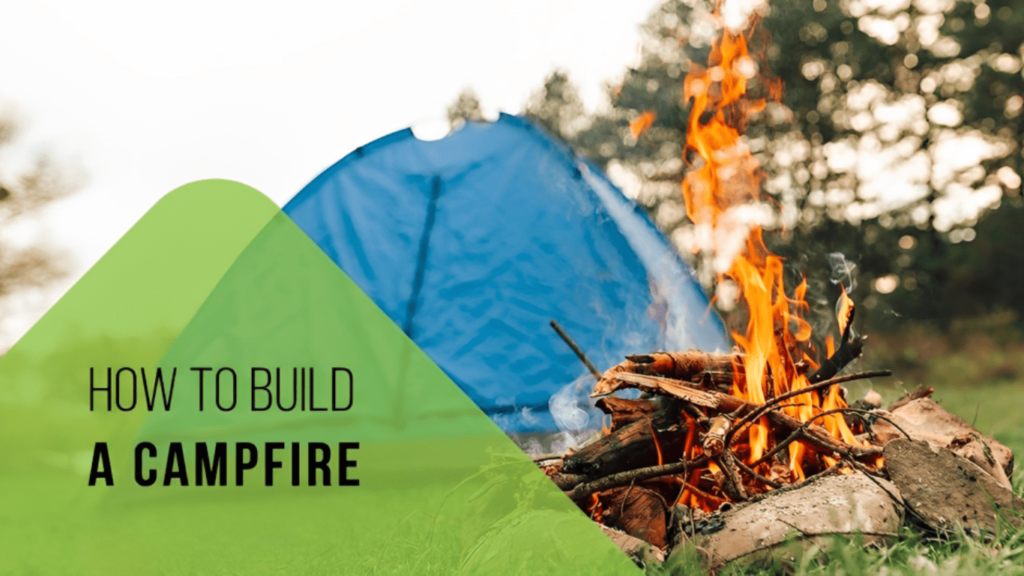
Hey, Jack here. I’m hooked on your website’s content – it’s informative, engaging, and always up-to-date. Thanks for setting the bar high!